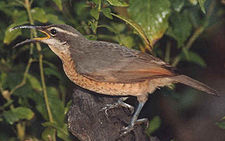
Victoria's Riflebird
Encyclopedia
The Victoria’s Riflebird, Ptiloris victoriae also known as Duwuduwu to the local Aboriginal
people, is a bird of paradise endemic
to the Atherton Tableland
region of northeastern Queensland
, Australia
where it resides year-round.
The smallest riflebird, it measures between 23–25 cm. Male have an iridescent purple sheen plumage, which becomes more blue-green on the head and more bronze on the lower breast. The throat is velvety black with a metallic green and blue triangular patch in the center. Females have a pale eyebrow, and the buff underparts are faintly barred with brown. The call is a loud "yaars".
As well as insects, they eat fruits from the trees, some which they peel by holding the fruit with one foot and removing the skin with their bill.
The Victoria's Riflebird was discovered by John Macgillivray
for John Gould
in 1848 and is named after Queen Victoria of the United Kingdom
.
A common species in its limited range, the Victoria’s Riflebird is evaluated as Least Concern on the IUCN Red List
of Threatened Species. It is listed on Appendix II of CITES.

The female is attracted to the male's display post by his raspy 'yaars' call, which becomes softer and more tuneful during the display.
The pair then face each other closely, and each bird raises and extends its wings forward alternately in an increasingly rapid rhythm. Finally the male embraces the female with both wings, and copulation ensues.
Indigenous Australians
Indigenous Australians are the original inhabitants of the Australian continent and nearby islands. The Aboriginal Indigenous Australians migrated from the Indian continent around 75,000 to 100,000 years ago....
people, is a bird of paradise endemic
Endemism in birds
An endemic bird area is a region of the world that contains two or more restricted-range species, while a "secondary area" contains one or more restricted-range species. Both terms were devised by Birdlife International....
to the Atherton Tableland
Atherton Tableland
The Atherton Tableland is a fertile plateau which is part of the Great Dividing Range in Queensland, Australia. It is located west to south-south-west inland from Cairns, well into the tropics, but its elevated position provides a climate suitable for dairy farming. It has an area of around...
region of northeastern Queensland
Queensland
Queensland is a state of Australia, occupying the north-eastern section of the mainland continent. It is bordered by the Northern Territory, South Australia and New South Wales to the west, south-west and south respectively. To the east, Queensland is bordered by the Coral Sea and Pacific Ocean...
, Australia
Australia
Australia , officially the Commonwealth of Australia, is a country in the Southern Hemisphere comprising the mainland of the Australian continent, the island of Tasmania, and numerous smaller islands in the Indian and Pacific Oceans. It is the world's sixth-largest country by total area...
where it resides year-round.
The smallest riflebird, it measures between 23–25 cm. Male have an iridescent purple sheen plumage, which becomes more blue-green on the head and more bronze on the lower breast. The throat is velvety black with a metallic green and blue triangular patch in the center. Females have a pale eyebrow, and the buff underparts are faintly barred with brown. The call is a loud "yaars".
As well as insects, they eat fruits from the trees, some which they peel by holding the fruit with one foot and removing the skin with their bill.
The Victoria's Riflebird was discovered by John Macgillivray
John MacGillivray
John MacGillivray was a Scottish-naturalist, active in Australia between 1842 and 1867.MacGillivray was born in Aberdeen, the son of ornithologist William MacGillivray. He took part in three of the Royal Navy's surveying voyages in the Pacific...
for John Gould
John Gould
John Gould was an English ornithologist and bird artist. The Gould League in Australia was named after him. His identification of the birds now nicknamed "Darwin's finches" played a role in the inception of Darwin's theory of evolution by natural selection...
in 1848 and is named after Queen Victoria of the United Kingdom
Victoria of the United Kingdom
Victoria was the monarch of the United Kingdom of Great Britain and Ireland from 20 June 1837 until her death. From 1 May 1876, she used the additional title of Empress of India....
.
A common species in its limited range, the Victoria’s Riflebird is evaluated as Least Concern on the IUCN Red List
IUCN Red List
The IUCN Red List of Threatened Species , founded in 1963, is the world's most comprehensive inventory of the global conservation status of biological species. The International Union for Conservation of Nature is the world's main authority on the conservation status of species...
of Threatened Species. It is listed on Appendix II of CITES.

Mating habits
When the male begins to display, he erects the feathers of his throat and sides to accentuate the bright colours of his plumage in the shafts of sunlight that pierce the dimness of the rainforest. He curves his rounded wings above his body and tilts his head back to expose his chin and throat to the light, and then moves from side to side in a fashion that looks almost mechanical.The female is attracted to the male's display post by his raspy 'yaars' call, which becomes softer and more tuneful during the display.
The pair then face each other closely, and each bird raises and extends its wings forward alternately in an increasingly rapid rhythm. Finally the male embraces the female with both wings, and copulation ensues.

